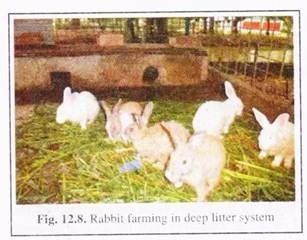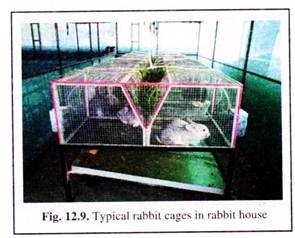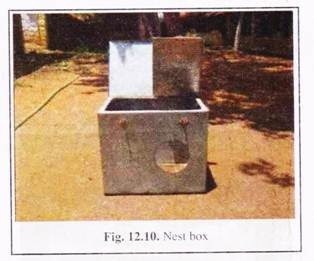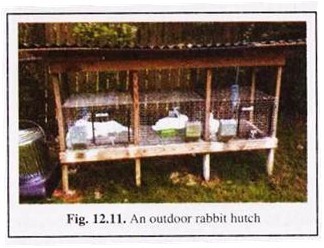Rabbits can be reared in two systems:- 1. Deep Litter System 2. Cage System.
1. Deep Litter System:
In this system, small number (not more than 30) of rabbits are reared in an enclosure within the farm house (Fig. 12.8). To prevent rabbits to dig burrows, the floor is made up of concrete. Litter materials such as paddy husk, paddy straw or wood shavings are put on the floor up to 4-6 inches.
Male and female rabbits are housed separately. Deep litter system is not suitable for intensive system of rearing. Rabbits reared in deep litter system are more susceptible to diseases. Management of bannies are also very difficult in deep litter system.
2. Cage System:
In farm house, rabbits can be reared by keeping them in different cages.
ADVERTISEMENTS:
(a) Adult Cage:
Cages for doe are usually of 90 cm in length and 70 cm in breadth and 50 cm in height and those of buck are usually of 60 cm in length. 60 cm in breadth and 45 cm in height. Cages are made up of wood, bamboo, or weld mesh. The size of wire mesh should be 1 cm x 1 cm for the bottom and 2.5 cm x 2.5 cm for the sides.
From the ground to the bottom of cage, there must be a space of 75 cm to 90 cm. The leg of the cages should be protected by metal guards to prevent nuisance caused by rats, snakes, etc. The cages should be placed in cooler surroundings.
ADVERTISEMENTS:
(b) Cage of Young:
Young rabbits after weaning are kept in groups in cages or pens (Fig. 12.9). Each such cage/pen measures about 1.5 m in length, 1.2 m in breadth and 0.5 m in height. Several such cages may be placed closed together on floor or stand in the rabbit house.
About 20 weaning rabbits can be reared in each cage/pen. Once the young attains maturity, they may be housed singly, especially adult males. If they are kept together, they will fight and get injured.
(c) Cage for Kindling:
ADVERTISEMENTS:
The cage of pregnant doe is almost like that of above cage. But the bottom and sides of such cage should be made of weld mesh of 1.5 cm x 1.5 cm. It will prevent the young bunnies to come out of the cage.
Nest Box:
To provide safe and calm environment during kindling, a mother doe should always have access to a nesting box, kept inside the kindling cage. Usual size of such box is 22 inches in length, 12 inches in breadth and 12 inches in height. Sizes can vary but should always provide enough space for each doe to keep her litter close together. Nest boxes are designed to open in the upper portion (Fig. 12.10).
The bottom of the box should be made up of weld mesh of 1.5 x 1.5 cm. A circular hole of about 15 cm diameter is made (10 cm up from the bottom line) on any one side of the box. This hole allows the doe to move from the box to kindling cage.
Designing the hole 10 cm up from the bottom line prevents the kits coming out from the box. Nest boxes can be made of galvanised iron, wood or metal sheets but never of plastic materials.
Hutches:
Rabbits can also be reared outdoor by keeping them in hutches that are placed in sheltered location with slopping waterproof roofing. Hutch is made up of wood/ asbestos and weld wire meshes (Fig. 12.11). It should be well protected from predators. Litter materials like- those of deep litter system, may sometimes be used on the floor of hutch. Such hutch can be kept in backyard also.



